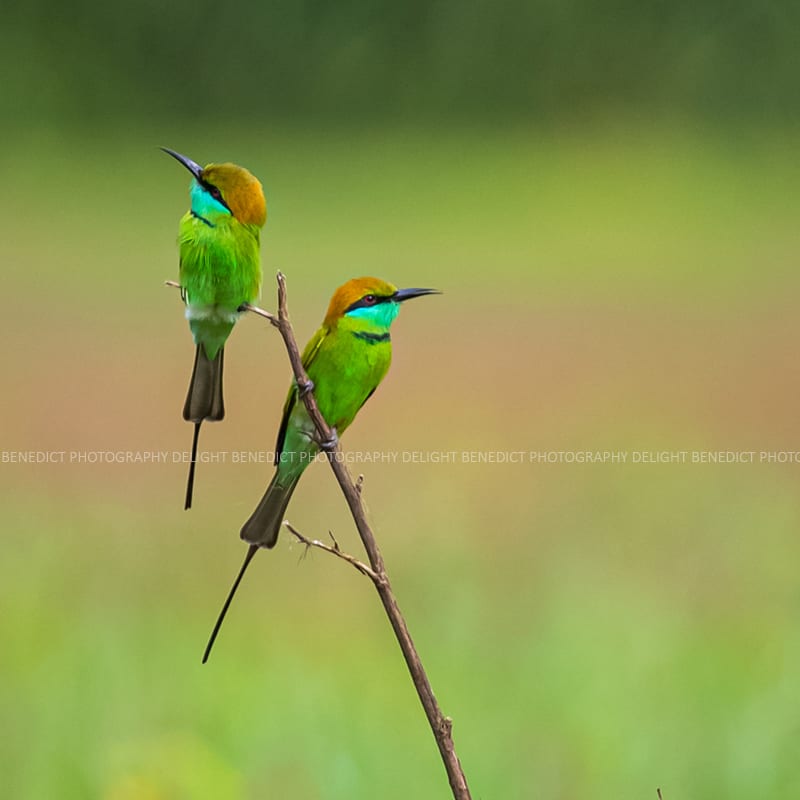The Amazing Green Bee-Eater
The Green Bee-Eater is a tiny, beautiful bird found in parts of Asia and Africa. Known for its unique and stunning emerald green color plumage, it is also commonly referred to as Little Green Bee-Eaters. There is often confusion with another member of the family which is known as Little Bee-eater. The Latin name for the bird is Merops Orientalis.
The species differ across the countries they are found. For example Merops Orientalis Beludschicus found in Iran to Pakistan has paler colors with a blue throat. The Green Bee-eater generally has a narrow black stripe known as a ‘gorget’ on his throat. It has a black mask running through its crimson eyes. The two central narrow, long black tail streamers are distinctive and unique, usually only found in mature birds. The Green bee-eater is one species where both the male and female birds look the same.
You can find the Green bee-eater in vast stretches from Mauritiana in West Africa to sub-Saharan Africa, as well as the Middle East and India as far in the north as Nepal. In Southeast Asia, you can find the Green bee-eater in China, Thailand, and Vietnam. They tend to frequent wooded areas where there are scattered bushes and trees. While they keep near streams and shores, you can also see them in arid areas that have acacia and date palms or in dunes, near cultivated areas, and big gardens. The green bee-eater is fond of bare and sandy soils. They are mostly seen in the plains but can sometimes be found up to 5000 or 6000 feet in the Himalayas.

The social habits of the green bee-eater are quite interesting. They are gregarious birds, eager to interact with each other. You can find 30-300 birds roosting next to each other on a branch. About 20 of them will gather to dust bathe together. Dust bathing is supposed to help remove excess oil from their feathers and dislodge harmful parasites. Green bee-eaters flock and sleep together at roosts, quite high in trees. During nighttime, one can find them perched low. Green bee-eaters forage alone or with a group of 15 to 20 birds. They tend to hunt low to the ground, making short swoops before returning to their perch. Green bee-eaters perch on the backs of cattle or grazing antelope, making sallies into vegetation close to the ground to catch insects. Before consuming their prey, they remove any dirt by striking the insect several times against a hard surface. Green bee-eaters make short sharp sounds or trilling calls. As their name suggests, they consume bees but they also eat insects such as bugs, beetles, termites, moths, flies, and Hymenoptera. Other foods include butterflies, crickets, dragonflies, caterpillars, and spiders.
Green bee-eaters are monogamous breeders. This means that a male will mate with only one female and a female will mate with only one male. Their breeding season ranges from March to July or August, depending on the range. Green bee-eaters are solitary nesters in Arabia and Africa. But small colonies can be found in India with larger colonies (10 to 30 breeding pairs) in Myanmar and Pakistan. Green bee-eaters nest in burrows that are dug by both male and female into the flat ground or a gentle slope in Africa, while in Asia it is often into a low shore. The burrow of the green bee-eater measures one to two meters in length, with the nest-chamber of around 15 cm at its end. 4-8 white eggs are laid in the chamber and incubation is 18 to 22 days, mainly carried out by the female. The young stay in the nest for 22 to 31 days while being fed by both their parents.
Fortunately, the green bee-eater hasn’t seen any major threats to its population or habitat. But the biggest threat remains to its food source, the bees, and if bees continue to decrease, this could be dangerous and a problem for the birds and their existence. Green bee-eaters are natural-born bee killers. Young birds who have never even seen bees before can catch and deal with them instinctively. The green bee-eater has a distinguished predator avoidance behavior. If a predator looks at the bird’s nest, the green bee-eater won’t enter the nest until the predator looks away. This intriguing behavior indicates an awareness of the bird about danger and predators. It also suggests that the predators can predict patterns to find traps and prey. The ability of green bee-eaters to know the point of view of their predators is supposed to be rare and only possessed by primates. Green bee-eaters know to disarm their prey or insects by removing their stingers. They eliminate the venom present in bees by hitting them against a branch. Bee-eaters follow large mammals and ground birds around as they stir up insects while moving.

